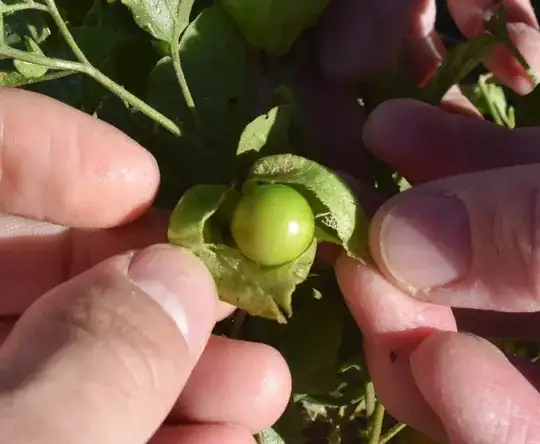Tomatillos are Physalis philadelphica (formerly Physalis ixocarpa). I believe that is the only species in the Physalis genus that is truly considered a tomatillo. Most of the other species in the Physalis genus are considered ground cherries (although a lot of people like to call ground cherries tomatillos for some reason—but as far as I can tell, that's inaccurate).
What you have there appears to be in the Physalis genus, but it is definitely not Physalis philadelphica. It's also not any ground cherry that I'm familiar with, offhand (e.g. Aunt Molly's, Goldie, Ammon Martin's, Yellow Husk, Cape Gooseberry, Chinese Lantern). It's almost assuredly wild (and not ferral).
The fruit looks a lot like ground cherry fruit usually does (however, the leaves are different than any I'm familiar with). It should be quite toxic until it's ripe. It won't be ripe until it falls off the plant. Because it's an unknown species, it could possibly be toxic even after it's ripe (but many wild ground cherries are fine to eat once they fall off the plant).
Ground cherries do not split the husk when they're ripe (like tomatillos do). You have to wait until they fall off the plant (you can do that for tomatillos, too, but tomatillos are ready when the husks burst). I'm not sure if Chinese Lantern falls off when ripe, however (I'm still trying to figure that out, although I am growing it).
Taste may vary from species to species and variety to variety. It may taste even sweeter than a tomatillo. It might not taste good at all, on the other hand.
Ground cherry fruits are not usually green when they fall off the plant (but they may be if the plant is stressed; however, I've found that the ones that have fallen on ground are still sweet if they're green due to a stressed plant, so long as they've fallen off the plant on their own; this may or may not be true for what you have there). Usually they're yellow or an amber-type color. Chinese Lantern has red fruits, however.
I can't recommend that you taste this ground cherry. It might be poisonous. What I would recommend is contacting your extension office and see if they can identify it. They should know a lot about local plants.

